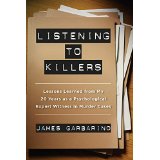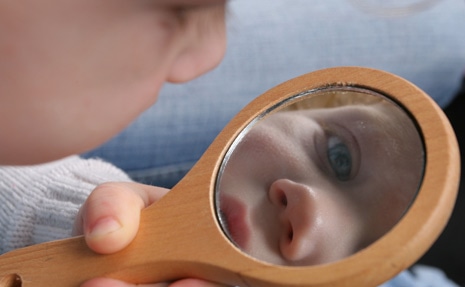Tune in Wed 4/22/15 @ 10am PT to A Rumor of Empathy to hear more.

James Garbarino presents lessons learned from his twenty plus years as a psychological expert witness in murder cases. Having understanding for the victims of violent crimes and the survivors is relatively easy for any decent human being. It is easy to include the survivors in the circle of caring of the community. However, what about understanding the killer? What about getting inside the head of the killer? What about getting inside the heart â or what is left of the heart of the killer? Some people would deny that killers are human beings sitting on death row; and no one is proposing to let dangerous men (or women) out of jail. But James Garbarino has made it his lifeâs work to discover the humanity that lies within. The journey is both confronting and inspiring.
Garbarino acknowledges the risk of over-simplification, but he sees the compelling value of getting the killers to answer these question: How did you get here â death row or life in prison without parole? What do you think happened? The narratives are confronting, in some cases breath-taking, and engaging to us individually and as a community. What hope is there and what specific recommendations can be made to restore the humanity of those entangled in the consequences–anticipated and unexpected–of their own lethal upbringing and folly?
While there are many approaches to empathy, Garbarino takes as his working definition that there is a circle of caring among human beings. The circle of caring defines the community, and being empathic means including the other person within the circle of caring. The circle of caring means that one is defined as a human being. It does not mean dangerous people who kill other people should not be locked up. Hence, Garbarinoâs project: include killers in the circle of caring in the sense that they are human beings, who have killed, and from whose account we can learn.
Garbarino has interviewed and reported to the court on behalf of some sixty killers. When Garbarino believes the circumstances warrant intervention, he goes to bat for the individual, not to release the individual from prison, but to spare his life. In the cases of individuals who were teenagers when the crime was committed, he intervenes to allow for the possibility of rehabilitation and parole rather than life-long incarceration. The first thing we learn is that the account of their lives is not for the faint of heart. There is a significant risk of retraumatization â to the reader â because most killers are surviving in a state of ongoing traumatization. In case after case, the individual was living in a extreme situation â feeling their life was in danger, feeling the need to carry a weapon in order to keep from being âjumpedâ (and beaten) on the way to school. Carrying a weapon greatly increases the likelihood that it will be used. One personâs self-defense is anotherâs defense of honor, and yet anotherâs preemptive assault.
The patterns and habits of those who survive an upbringing in what is described as a âwar zoneâ â including but not restricted to the inner city â acquire hyper-vigilance, an acute threat awareness, a keen perception of provocation. To any ordinary person such a disposition would be a chronic post traumatic stress disorder case. But to people who grown up in marginal circumstances as the neglected offspring of drug dealers, the habitually incarcerated, or the criminally insane, the result is a validation of aggression in response to perceived lack of respect, honor, or recognition. This is not the complete story â for that get the book â but time after time the compelling conclusion is that the killer is living in a different community and a different world than the standard middle-class context that most of us call home.
One of Garbarinoâs lessons learned is that in prison individuals either become monsters or monks. Once an individual is imprisoned, the possibilities for real dehumanization in the form of rape and physical abuse escalate rapidly. The individual either lives into the dehumanizing context of living in a cage and becomes the animal who really does need to locked up; or the individual embraces an ascetic ideal, and live without memory or desire. It is not clear how the monks get the monsters to leave them alone, but some kind of accommodation seems to be reached.
In interview after interview of these scary monsters â tattoos, rippling muscles, vacant eyes â Garbarino brings forth the disturbing fact that their emotional and cognitive development was often cut short at five years old, eight years old, and so on, due to dysfunctional families, no families, or worse. One killer cries himself to self at night, missing his teddy bear. Indeed. Many are psychologically children in the bodies of very scary men. This is where Garbarino is quick to note that no one is advocating letting them out of prison. Garbarino makes the case that, given what they have been through, where is the justice in killing them, notwithstanding that they were convicted of murder?
Garbarinoâs narrative is a clearing for âwhat is soâ; and what is so is a collection of breakdowns and failures at the individual and community level for vast and deep that it is hard to know where to engage. That Garbarino takes a powerful stand for humanity and what is possible. This is evidence of the strength of his commitment and indeed the commitment of anyone out to make a difference.
This is where Garbarino takes his argument for compassion and empathy (they are not the same thing) up a level or two. The details of the lives of the killers prior to incarceration are harrowing. Anyone who had been through what most of these killers went through would be just like them â bombs waiting to go off â bombs that have gone off, leaving fragments and ruin. There is a strong element of âthere but for the grace of God go Iâ to this narrative. Implicit in this argument is we are a community.
It is hardly a digression, but there are a number of background institutions and organizations that are a part of the problem at the level of community, not the solution. The for-profit industry that operates prisons is a strong lobby in favor of mandatory sentencing and a punitive approach to sentencing â it increases the prison population and the number of âcustomersâ. The conflict of interest here is appalling. No surprise, the National Rifle Association has been effective in shutting down research into the negative health effects of the ready availability of fire arms. What needs to be better known and appreciated is that having a gun in your home may be useful in the rare event of an intruder, but it greatly increase the chances by integral factors that the gun will be used against the owner or a family member in an accident, suicide, homicide, or related act of violence. Grim. The NRA takes no responsibility and does not want you to know.
Without undertaking to deconstruct the history of racism, the destruction of the African American family by slavery, and the marginalization of black men of color, especially young men, Garbarino does not assume that the reader just âgets itâ. Once in the prison system, there is a strong chance that the individual will learn all the wrong lessons and become a hardened criminal. All the more reason then to find alternatives to incarceration that emphasize rehabilitation, training, therapy, socialization, for those able to use such services. This is not a system in which you want to get entangled. Garbarino manages to find ray of hope and some exceptions. In one happy instance, the prisonerâs mother had the commitment and resources to hire a psychotherapist for the individual. It helped a lot. It made a difference. This was one case. There are apparently some opportunities for the equivalent of correspondence courses, education, and training. Resilience is the exception not the rule, but it does occur. Mandatory sentences and imprisonment without the chance of rehabilitation or parole for someone who is still young is a form of cruel and unusual punishment and so unconstitutional (argues Garbarino). Also, strongly implied by Garbarino: As a community, we have sown the wind; and we are reaping the whirl-wind in terms of violence and growing numbers of incarcerated â and lost â lives. Garbarino makes a strong case that we need more rehabilitation and less punishment; expanded possibilities and less retribution; more compassion and fewer fire arms. Garbarino finds that the psychologist ignores the progress of empirical science at her or his peril. Progress is being made in the predicting modeling of the outcome of the tough, confronting decisions that have to be made by parole boards. For example, the research of Robert Zagar (Garbarino 2015: 180) combines dozens of factors and lots of historical data to produce a result that seems to hold water in determining who is a good risk for parole.
In the final analysis, Garbarinoâs credential as a kind of Buddhist Catholic (my description) serve him well. Convicted felons are not able to vote, they face a high bar in finding a job with such a label in their file, and they often lack education. These are the people who Jesus of Nazareth came to be an advocate and spokesman for. They are not affluent, well rested, well connected, and influential. They are the lowest of the low. Garbarino succeeds almost beyond measure in being a voice for killers. They get a hearing. It is not always easy to listen to â but the humanity is there in a way that needs to be heard. Our thanks to Jim for the contribution and for the journey, still underway.




